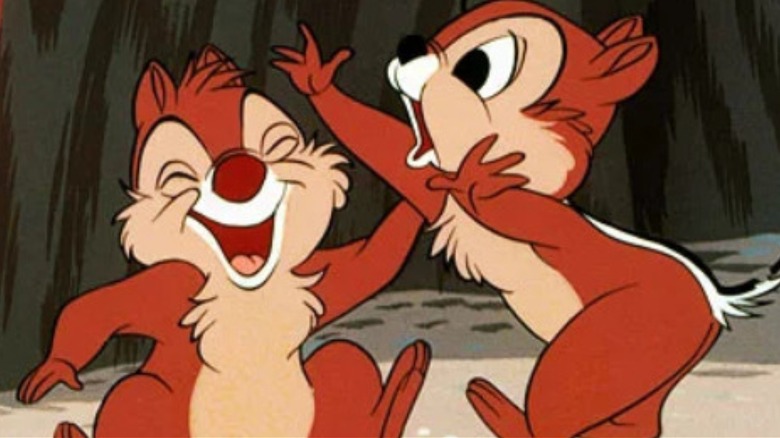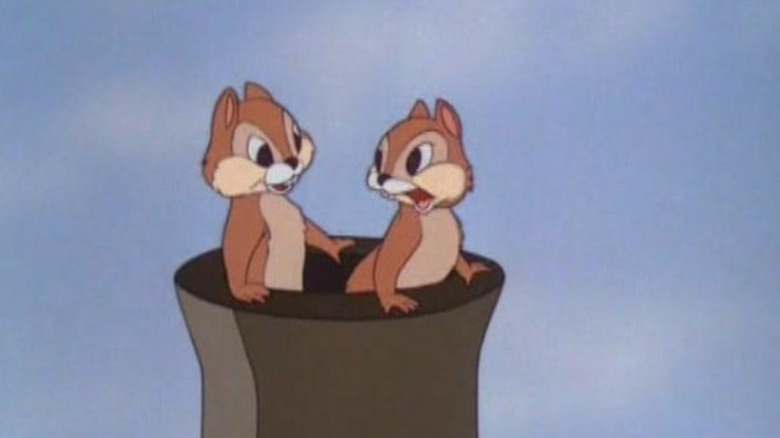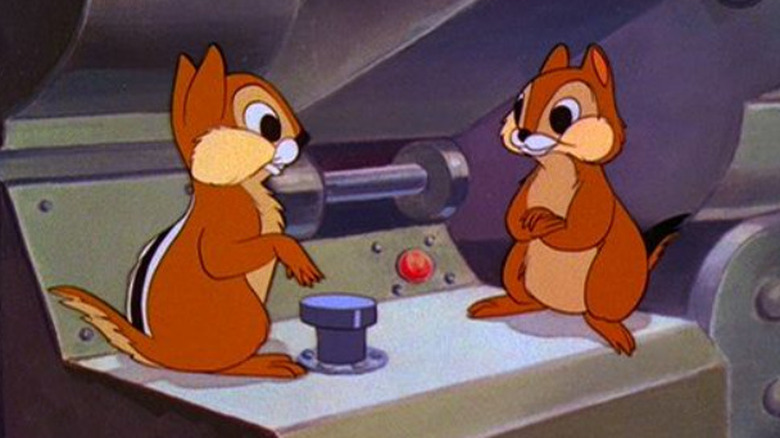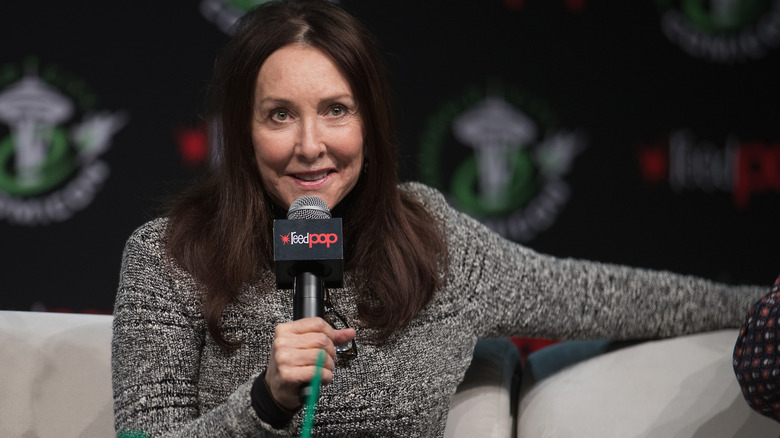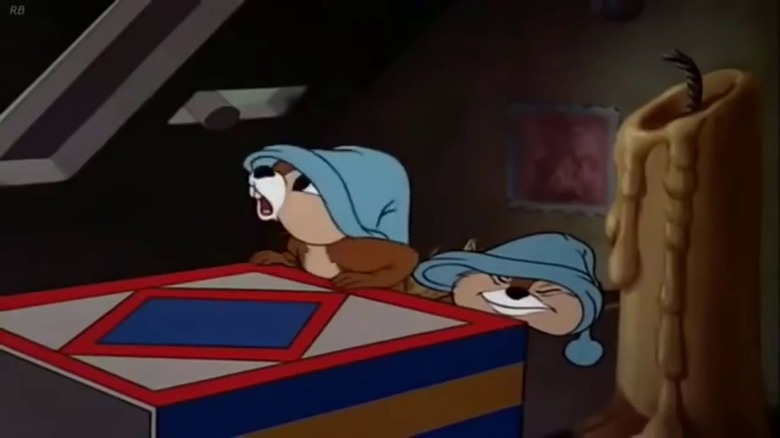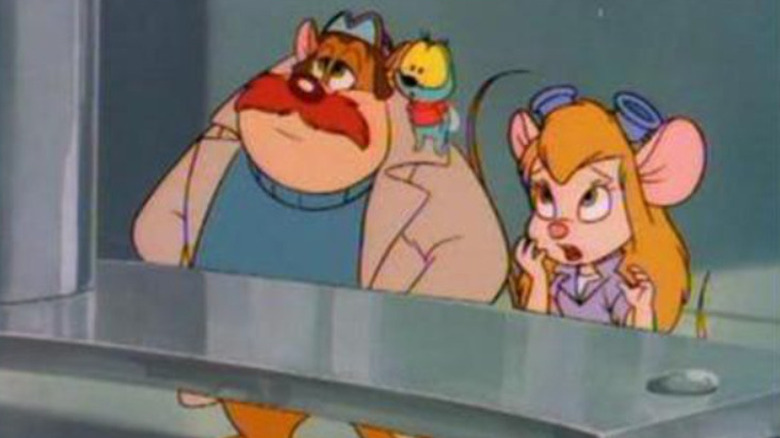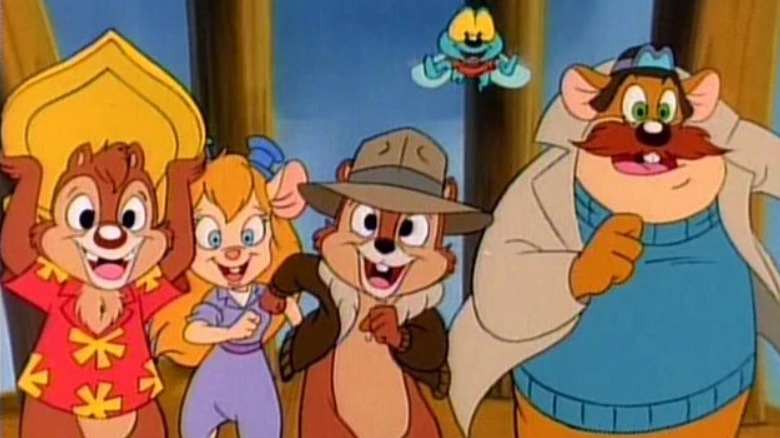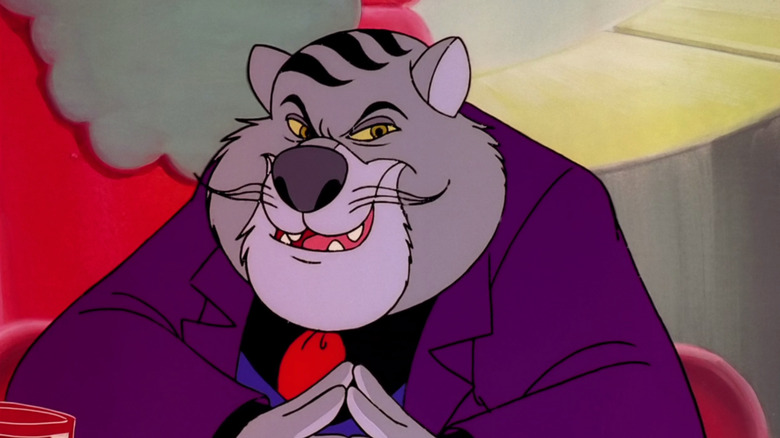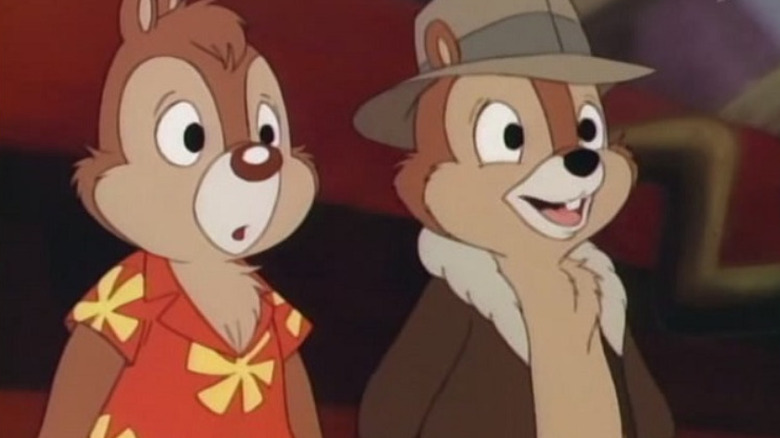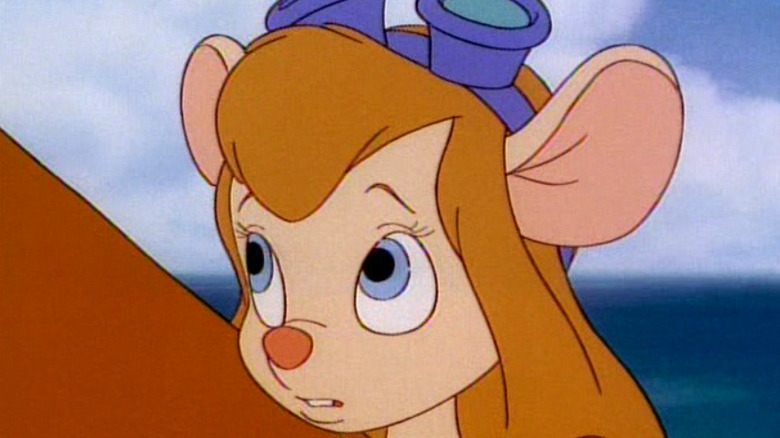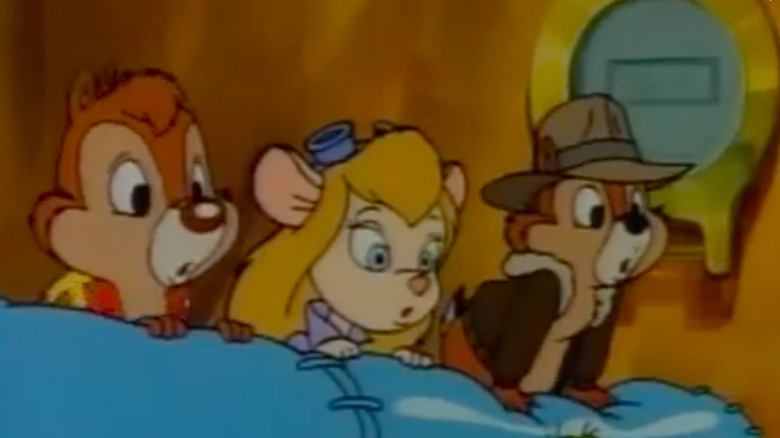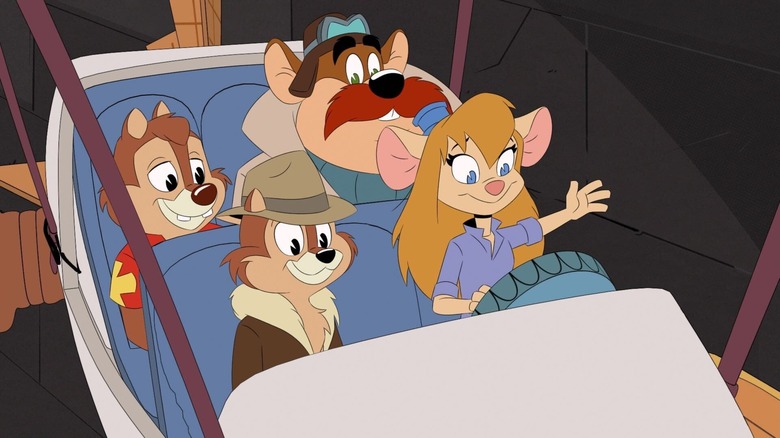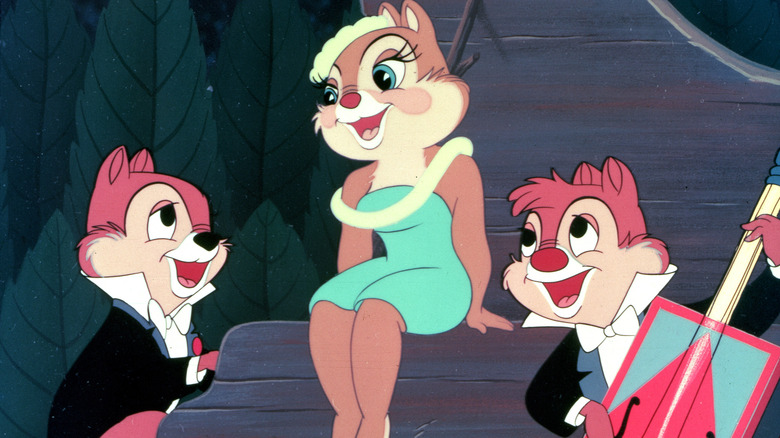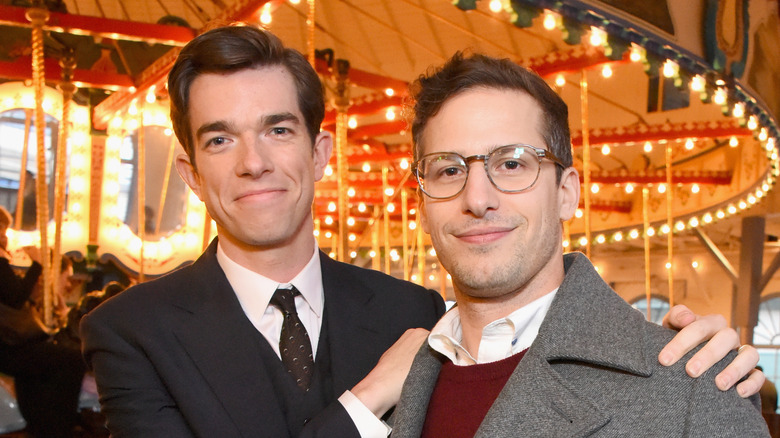The Untold Truth Of Chip 'N Dale
When fans think of Disney cartoon shows, the main characters that come to mind are the big names, like Mickey Mouse, Donald Duck, and Goofy. But the Mouse Empire has a vast repertoire of secondary and tertiary characters without whom the cartoons would feel empty.
One such comic duo that has been entertaining Disney audiences for decades are the mischievous chipmunks Chip and Dale (usually spelled Chip 'n Dale). Starting out as tiny antagonistic characters for Pluto and Donald, Chip and his best bro Dale were an instant hit with fans in the vein of other adorable animated rodents like Alvin and the Chipmunks and Jerry Mouse.
Although they began as secondary characters, Chip and Dale took center stage in the late 1980s by headlining their own half-hour show on Disney TV, "Chip 'n Dale: Rescue Rangers." The show reinvented the main duo as a couple of sleuths who solve crimes relating to the animal kingdom amidst a host of new supporting characters. Thanks to the popularity of the show, and their previous appearances in classic Disney shorts, Chip and Dale have enjoyed enduring popularity in their own right. Here are some essential facts about the fan-favorite chipmunks that you need to know.
They started out exactly alike
These days, everyone knows Chip and Dale are as different as chalk and cheese. Chip is the smart one, who can think his way out of any situation, and backs up his brains with hard work and tenacity. Meanwhile, Dale is the easy-going one — he's not overly bright, and rarely bothers to make much of an effort if Chip wasn't firmly prodding him on from behind.
But when the duo first debuted in the 1943 animated short "Private Pluto," they were identical in every way from their appearance to their squeaky manner of talking down to their personalities (via D23). At the time, their role was as the antagonists who get in the way of Pluto the Dog's duty guarding a military pillbox. It was only when Chip and Dale were reintroduced three years later in a string of Mickey Mouse and Donald Duck shorts that their personalities started to differentiate.
As explained by Disney animator Jack Hannah (via Cartoon Research), "[Fellow animator] Bill Peet came up with the suggestion of making one of them a little goofball to give them two different personalities." As Chip and Dale started to make more regular appearances, they also began to be drawn differently. Chip got smooth hair, a small black nose and two centered protruding teeth, whereas Dale received ruffled hair, a large dark red nose and a prominent gap between his buckteeth.
They were originally voiced by females
It is generally understood that Chip and Dale are males, and therefore have the freedom to roam around wearing shirts and jackets with no pants. But a surprising number of male characters in cartoons are voiced by females, especially when the characters are meant to be depicted as either pre-pubescent or extra cutesy.
Since Chip and Dale tick both boxes, it is unsurprising to discover that they had some feminine energy behind their voices in their earliest appearances. Dale's modern voice actor, Corey Burton, mentioned in an interview that the earliest voices for the chipmunks were "originally special effects 'chatter', provided by female staff from Disney Studios' Ink & Paint Department and secretarial pool, and part-time actresses." In the next few shorts they appeared in, Chip was voiced by James MacDonald while Dale is credited as being voiced by Dessie Flynn.
Of course, back then there was no discernible dialog accorded to either Chip or Dale. The two essentially spoke in quick gibberish, which were regular human sounds sped up to become indistinguishable. It was only later when Chip and Dale were starting to become popular that they were given words to speak, although their lines were still sped up to mimic the high-energy quality of real squirrels.
Talking to themselves
When they first started appearing in Disney shorts, Chip and Dale had little need for a dedicated voice talent, since they basically spoke gibberish. Even the times they spoke words, the speed of their diction made the whole thing unintelligible to younger viewers.
But a few decades into their careers, Chip and Dale had become established characters in their own right, with their own cartoon shorts, comics, and even merchandise. As the popularity of Chip and Dale continued to grow, they started getting their own special voice actors to voice them on different projects. Since 1988, Chip has been voiced by Tress MacNeille while Dale is usually voiced by Corey Burton.
There are times when Burton is not available to voice Dale. At such times, MacNeille voices both Chip and Dale, and is essentially talking to herself as both characters, like in "Mickey's Magical Christmas: Snowed in at the House of Mouse" (2001). According to an interview with Burton, he based his voice for "Dale" on James MacDonald's voice acting and actor Carl "Alfalfa" Switzer (of "The Little Rascals" fame), while MacNeille based Chip on "on those [voices of Chip from the earliest shorts], delivered 'in harmony' with [Burton's] take on Dale."
Are they actually brothers?
At this point, it is common knowledge that Chip and Dale are brothers, with the only point of contention being whether they are twins or whether one is older than the other. But like a lot of pop culture myths, this one is inaccurate. At no point in any of the shorts, series, or any related media are Chip and Dale stated to be brothers.
Since the comic duo seem inseparable and are seen living together, working together, and generally acting closer than family, it seemed a safe assumption that Chip and Dale are brothers, or cousins at the very least. But the fact remains that there is no piece of official media that can confirm or deny their relationship. Seemingly the only piece of confirmation that exists can be found in author Dave Smith's book "Disney Trivia from the Vault: Secrets Revealed and Questions Answered."
In the book, Smith makes the claim that Bill Justice, the animator who drew the first Chip and Dale cartoons, described them as "simply little brothers." While that is the opinion of one animator, and not the official line taken by Disney, Chip and Dale being brothers has become such a pervasive part of their lore amongst fans that it might as well be true.
The Rescue Rangers minus Chip and Dale
For the first few decades of their careers, Chip and Dale were popular supporting characters for Donald, Mickey, and the rest of the main stars of Disney animation. But the year 1989 was set to bring about a massive change in the way the chipmunk duo were seen in popular culture, with the arrival of the half-hour mystery-adventure show "Chip 'n Dale: Rescue Rangers."
The fact that Chip and Dale were in the show at all was something of an accident. When esteemed Disney animator and producer Tad Stones first pitched the idea for the show, it was headed by a new character named "Kit Colby," who Stones described in an interview with AWN as a mouse with an "Indiana Jones"-style jacket and collar.
But the producers in charge of the show did not feel Colby could be a "leading man" character. That was when Stones started thinking of an already established Disney character that could headline the new show. "You don't want to do Mickey or Goofy, but there's Pluto and all that," Stones mused. "Finally, I said, There's Chip and Dale. [Michael] Eisner said, great put those guys in that show, and Jeffrey [Katzenberg] says home run."
An evolving lineup of Rescue Rangers
While Chip and Dale were fairly popular before, "Chip 'n Dale: Rescue Rangers" was the show that put them on the map and made them stars, along with the rest of the main cast of Gadget Hackwrench the genius mouse inventor, Monterey Jack the short-tempered but kind-hearted Australian mouse, and Zipper the loyal fly.
The playful dynamic between the characters was what made ""Chip 'n Dale: Rescue Rangers" so memorable. But it could have almost been very different. We've already talked about the initial leading character of Kit Colby who was replaced by Chip and Dale. In an interview for Pirates & Princesses, the show's creator Tad Stones also revealed that while Gadget was always part of the ensemble, there were a bunch of additional characters that were eventually cut.
"We originally had a version of Monterey Jack," Stones recalled in the interview. "We had Gadget and Zipper the fly but we also had a chameleon who wore plaid and she was like the secretary of the group. There was an Asian cricket. They also flew around on a near sighted bald eagle." When the creative team decided to cut down on the number of main characters, the bald eagle's absence was compensated for by Gadget's fan-favorite "Ranger Plane" that the team used for travel.
Live-action inspirations
One thing that makes "Chip 'n Dale: Rescue Rangers" so entertaining to watch even as adults is that it draws on so many live-action inspirations with regard to the settings and characters. The main villain Fat Cat looks to have stepped straight out of a mafia movie, while the villain Professor Norton Nimnul would be right at home in a superhero film.
This habit of being inspired by live-action media can be traced back to the genesis of the show itself. Back then, "Miami Vice" was a popular show on television, and Tad Stones and his collaborators came up with its Disney pastiche "Miami Mice," which was later renamed "Metro Mice" for legal reasons. "The first shot was just a mouse police station," Stones explained to Pirates & Princesses when talking about the show in its earlier avatar.
"Even the artwork had guns, which was crazy to think about. We realized the problems of doing Hill Street Blues in the mouse world was that you couldn't to the normal police crimes they'd be too violent." To offset any unnecessary violence, the show became more about helping innocent animals caught up in criminal circumstances rather than punishing the perpetrators of the crimes.
The clothes make the chipmunks
When Chip and Dale were chosen to front their new show "Rescue Rangers," their personalities and appearances were heavily retooled to fit the role of adventurers and problem solvers. A big part of the reboot was giving the two characters clothes to wear, which included a hat and jacket for Chip and a red Hawaiian shirt for Dale.
Older fans immediately recognized Chip's ensemble as a homage to Indiana Jones, the famous archeologist/adventurer who has become an enduring icon of pop culture. As far as Dale's shirt was concerned, fans assumed it was a reference to Magnum P.I., a popular private investigator played by Tom Selleck in a drama series.
As it turns out, only one of those homages was intentional. When the creator of the show Tad Stones was asked about Chip and Dale's clothing, he explained to Pirates & Princesses that Chip's hat was indeed inspired by Jones' hat, while Chip's jacket was a holdover from the previous lead character of the show, Kit Colby. But as far as the Hawaiian shirt is concerned, Stones stated, "When I saw the color model of the red shirt I must have said to a PR person but I said 'Yeah it's Indiana Jones and Magnum P.I.' But it wasn't meant to be a direct connection."
The cult of Gadget Hackwrench
While Chip and Dale were the stars of the series, "Chip 'n Dale: Rescue Rangers" was essentially an ensemble show where all the main characters were given their chance to shine. An instant fan-favorite was Gadget Hackwrench, the genius inventor and slight ditz whose creations were as liable to get in the way as help the team.
There are many Disney fandoms exclusively dedicated to Gadget, but some fans take it a step further by forming a cult around the fictional character. That is what a number of internet news outlets started reporting around 2010. According to The Mary Sue, the members of the cult belong to Russia, and they consider Gadget to be the "Ideal female" who is "strict, cute, optimistic and her level of technical knowledge is unachievable for a mortal being."
Of course, this being news that comes out of a translated piece of Russian video on the internet, there is no way to tell whether the members of the "cult" are serious about their statements, or the whole thing is some kind of a joke. But again, this being the internet, it is not too out there to imagine grown men developing a strange obsession with a cartoon mouse.
The forbidden episode
While "Chip 'n Dale: Rescue Rangers" centered on crime and its solving thereof, the creators of the show were careful to keep the storylines free of any controversial settings that might spell trouble for Disney. But sometimes, instead of looking for trouble, trouble comes to you, which is what happened with the show's 44th episode in its second season, "A Lean on the Property."
In the episode, a sub-plot involves the villainous Fat Cat making an effort to rid the city of its dog population. Fat Cat uses an army of underground moles to tunnel under the foundations of the city. This results in buildings tipping over and general chaos among the citizens.
Following the 9/11 terrorist attacks on New York, the episode was temporarily banned in America, since some of the imagery used in some of the scenes were reminiscent of the fall of the World Trade Center. But fans outside of the US could still watch the episode, and it has since become available everywhere on iTunes and Disney+. Interestingly, "Chip 'n Dale: Rescue Rangers" wasn't the only show to be censored due to 9/11, since a similar fate befell an episode of "Friends" following the attacks.
Crossing over with DuckTales
When "Chip 'n Dale: Rescue Rangers" first aired, it shared a time block with "DuckTales" and "TaleSpin." Together the three shows made up the iconic "Disney Afternoon" programming block when young fans rushed home to watch the cartoons one after the other. But then, three seasons and 65 episodes later, "Chip 'n Dale: Rescue Rangers" was canceled by Disney to make room for new content.
Despite its cancelation, the show continued to air on television and its fan base grew with each passing decade. So much so that when "DuckTales" was revived by Francisco Angones and Matt Youngberg in 2017, they made sure to include a cameo by the Rescue Rangers in the new series. In the episode "Double-O-Duck in You Only Crash Twice!" (Season 3, Episode 3), the villain Black Heron uses a ray that can alter a creature's intelligence.
Heron tests the ray on a couple of chipmunks and mice. Later in the episode, those same creatures are shown to have become Chip, Dale, Monterey Jack, and Gadget. The four briefly aid Launchpad in defeating Black Heron before flying off on new adventures in their Ranger Plane. They also make another appearance in the series finale "The Last Adventure," where the Rangers are shown to be captured by F.O.W.L. for eradication until Launchpad rescues them.
A forgotten love
Younger fans who mostly remember Chip and Dale from their "Rescue Ranger" days no doubt remember the love triangle that formed between Chip, Dale, and Gadget. The two chipmunks were head over heels in love with Gadget from the start, and never stopped trying to impress her despite the fact that Gadget herself mostly saw them as her friends.
But before losing their heart to a creature from another species, Chip and Dale were smitten with a fellow chipmunk. Her name was Clarice, and she sang at a nightclub. Chip and Dale battled fiercely for her affections, a dynamic that they would later repeat with Gadget. Despite being a popular favorite amongst fans, Clarice only showed up prominently in a single short called "Two Chips and a Miss," and later in archived footage from "Walt Disney anthology series" and "House of Mouse."
The next time she had an important role was many decades later in the 2021 Disney+ series "Chip n Dale Park Life." This time around, Clarice was shown to be much more of a tomboy. The director of the new series, Jean Cayrol, explained the major changes made to the character to make her more than eye candy, telling CBR, "Our Clarice is a badass independent chipmunk living above Chip 'n' Dale. And basically, she is the ultimate chipmunk ... she's basically everything Chip and Dale will never be able to achieve."
A live-action comeback
Although Chip and Dale started out as comic foils for Mickey, Donald, Pluto, and others in their Disney shorts, they really came into their own after headlining "Chip 'n Dale: Rescue Rangers." Despite the show being canceled more than three decades ago, it remains a popular piece of nostalgia for fans, who have been clamoring for some sort of a revival of the series.
That revival has taken the form of a live-action "Rescue Rangers" movie that was formally announced in 2020. The film is set to take a live-action/CGI hybrid approach where John Mulaney will voice the role of Chip, while Andy Samberg has signed on to voice Dale. Not much is known about the project thus far beyond Mulaney and Samberg's involvement.
But recently, while celebrating Disney+ day with fans, Samberg intimated that the upcoming movie is not going to reboot the original show. "Now, I know what you're thinking," the actor stated on Twitter. "Another reboot! No! But our film isn't a reboot. It's a comeback." So rest assured, the movie will stick to the classic formula for Chip, Dale, and their fellow Rangers instead of attempting any unnecessary reinventions.
